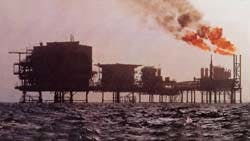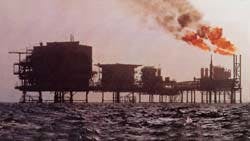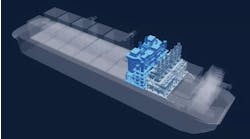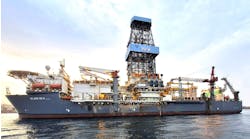Reservoirs recharging from below; reserves climbing despite long production history and few new discoveries
Robert F. Mahfoud
James N. Beck
McNeese State University (US)
Persian/Arabian Gulf reservoirs may be continually recharged from rift zones below.
- Increase in Saudi oil reserves. source: Hemer et al-1982; Hemer and Gohrbandt - 1986; World Oil -1994.
- A section across the Arabian peninsula during Miocene when the Red Sea began to open. It shows the rift zone over ophiolite in the Tethys Sea, before the diapiric movement occurred.
- The rift zone and magma chamberare magnified. Note the cumulative ultramafic and gabbroic rocks inside the chamber.
- A section showing the eastward movement of the Arabian peninsula, and the diapiric movement of peridotite which led to overthrusting on both sides of high elevations in the mountain range of Oman. Note the closure of sea by subduction.
- Map outline shows occurrence of oil fields through the Middle East, from the north of Oman (bottom right) to eastern Syria, corresponding to rotation, subduction, and rift formation associated with the Arabian plate.
- Table: Iron catalyzes carbon, hydrogen in subduction zones.
The topography of the Middle East, as it exists today, is the result of a geodynamic system reflected in the creation of subduction zones in Oman, along the Persian/Arabian Gulf area, along the Syrian-Turkish borders, and along the eastern shore of the Mediterranean Sea.
This system is also reflected in rift creation leading to the opening of the Red Sea, the Gulf of Suez, the Gulf of Aqaba, northward to southern Turkey, and between Syria and Jordan. The subduction and rifting are caused by the counterclockwise movements of the Arabian plate from Miocene to Recent, as evidenced by recent earthquakes.
The location and orientation of hydrocarbon fields appear to be controlled by and related to subduction and rifting activities. The formation of hydrocarbons are due to the chemical processes which take place, even today, within the subduction/rift zones, and deep into the basement.
The carbon and hydrogen, necessary for the formation of hydrocarbons, can originate from organic compounds, located in subducted sedimentary rocks, and from the dissociation of carbonates (CaCO3 ), and the reduction of carbon dioxide (CO2 ) and water (H2O) that seeps into subduction zones, or deep into rifts and fractures.
Furthermore, CO2 can be released from cracked olivine and pyroxene in lithospheric and basaltic rocks. The reduction of CO2 to carbon (C), and H20 to hydrogen (H2) is probably catalyzed by oxidizing ferrous iron (Fe+2 ) present in mafic minerals to ferric iron (Fe+3 ). The combination of C and H2, at 300-500°C, has formed paraffinic and naphthenic compounds (both present in the oils of the Middle East).
The continuous formation of hydrocarbons by this process, and the field locations along, near, or above subduction/rift zones, would account for the continuous increase in oil reserves, would explain why hydrocarbons are found close to those zones, and why the reserves are modest in Syria, Turkey, and Oman, relative to the huge oil reserves found in the countries along the Gulf.
The extensive literature on Middle East oils and oilfields, especially in the Persian/Arabian Gulf area, point out that hydrocarbons are formed from sedimentary petroliferous beds, mostly shales and carbonates. Organic materials locked in rocks have become accepted as the de facto source for the formation of huge hydrocarbon accumulations, despite the inability to pinpoint the exact source beds. The assumption is that petroliferous layers, above or below oil fields, are the source for the formation of hydrocarbons. This assumption leaves many unanswered questions, some of which are:
- Inexhaustible reserves: Why are yearly oil reserves increasing steadily despite the 10-20 million bbl of oil that have been pumped daily for decades from the Gulf area?
- Location: Why is oil found only to the west and south of the ophiolite mountain in Oman, and not also to the east, despite the presence of carbonates and favorable subsurface structures?
- Same environment: Why are the oil reserves in Turkey, Syria, and Oman ( the end-countries along the Gulf region) modest relative to the other reserves, despite the fact that all the countries of that region (except Iran) were under the same marine (organic) environment along the shore of the ancient Tethys?
- Similar geology: Why are hydrocarbons also found in serpentinites (Turkey - North, 1985), ophiolitic rocks (Hormuz area in West Oman and Sharjah - North, 1985), rift zones (north of Dead Sea - Hemer et al, 1982; southern Syria - Mahfoud and Beck, 1991), and Precambrian rocks (Libya - North, 1985; SE Gaza - Hemer et al, 1982), in addition to their presence in carbonates and sandstones?
From a scientific perspective, one can deduce that organic sources alone are not enough to explain them with satisfaction. Therefore, there should be another source and/or process capable of providing convincing answers. In addition to background on Gulf geodynamic activities, this article seeks to provide an explanation for the ongoing genesis of hydrocarbons in the Middle East and outline promising locations for future exploration.
Structural history
To understand the development of hydrocarbons and the locations of oil fields in the Middle East, it is important to mention the successive geodynamic events that shaped today's topography in the region since the break of the Arabian plate from Africa and the opening of the Red Sea, starting from Miocene time.
In Oman, the occurrence of ophiolite rocks indicates the presence of an ancient oceanic rift zone in the Tethys Sea during pre-Miocene time. In other words, the ophiolite mountain was non-existent, and the ophiolitic rocks (cumulative ultramafic rocks, gabbro, trondhjemite, lava flows, pillow lavas) were inside the magma chamber (at the bottom of the oceanic crust, or below it in the upper mantle), and on the ocean floor (flows and pillows).
During Miocene, the Red Sea started to open, and the Arabian plate to break away from Africa, by turning counterclockwise. The movement has closed the distance between that plate and the rift, and has created a subduction zone, whereby the plate was subducted below the rift. The continuous subduction events (Miocene-Recent) have broken and subducted sedimentary beds (carbonates, shales, etc), the oceanic basaltic crust, and the suboceanic lithosphere.
Also, they have compressed and squeezed out the ophiolitic rocks. Geodynamically, the compression-squeezing stress has forced the cumulative black peridotite to be uplifted plastically to its current position, forming the high elevations along the axis of the mountain range in Oman.
By this orogenic movement, the ophiolitic rocks and their sedimentary cover (limestones, radiolarite, shales - Hawasina Series and others) were broken, brecciated, and overthrust to the east and west. The westward overthrust (Glennie et al - 1973), is only part of the story and somewhat misleading for exploration.
During nine months of exploration in Oman, one of the authors (Mahfoud) mapped Miocene-Holocene structures, including vertical movements and eastward overthrusting, in addition to the westward overthrusting (Glennie et al - 1973).
The Hawasina Series (Cretaceous) and other sedimentary beds, to the east of the rift, were also faulted and folded by the orogenic movement in Oman. However, the oil accumulations were only found in the area of the subduction (to the west and south of the ophiolite mountain, but not to the east).
From Oman to NE Syria and SE Turkey, the successive counterclockwise movements (Miocene-Recent) of the Arabian plate have slowly narrowed the Tethys, forcing subduction to take place. The Tethys oceanic crust, its sedimentary cover (carbonates, sandstones, shales of different ages), and suboceanic lithosphere were, therefore, subducted beneath the Eurasian plate, uplifting the Zagros mountains. The subduction process continues to the present time, as evidenced by the occurrence of major earthquakes along the Zagros.
Subduction along the Syrian-Turkish borders, from the northeast of Syria to the northeastern corner of the Mediterranean Sea, has also uplifted and formed the mountain ranges in Turkey. The Tethys Sea is now totally closed from the northeastern corner of the Mediterranean Sea to the northwestern end of the Persian/Arabian Gulf, leaving only the Gulf to provide water to the subduction zone from southern Iraq to the strait of Hormuz in Oman. Earthquakes along the Syrian-Turkish borders are not as common as along the Zagros, and the water availability for seepage is inadequate.
Other subduction zones
- Eastern Mediterranean Sea: The counterclockwise movement of the Arabian plate, along with that of African plate, have forced another subduction event to take place along the eastern Mediterranean coast (Mahfoud and Beck - 1993), forming the coastal range.
Deep fractures, faults, and anticlinal structures are formed inshore and offshore beneath the floor of Mediterranean basin. Oil, gas, and solid hydrocarbons have been discovered in carbonates and sandstones in the countries along the coast (Syria, Lebanon, Israel). Commercial oil fields currently are being exploited in Israel (May and Goldberg -1986; Bein and Sofer - 1987). Offshore hydrocarbons are probably present, however, their bulk accumulations are capped by a layer of salt, over a km thick, covering the floor of the Mediterranean basin (Matthews - 1973). Drilling, therefore, should be very deep and over traps covering deep fractures and faults.
- Rifting: The Middle East is also plagued with rifts. Besides the Red Sea and the Gulf of Suez, rifting includes the Gulf of Aqaba, which continues northward along the Dead Sea - Jordan Valley, through the Bekaa graben in eastern Lebanon, and further north along the eastern side of the coastal Allawite Range in Syria, until it vanishes in southern Turkey.
Another ESE-WNW trending offshoot rift, between southern Syria and northern Jordan, is present, and connects with the Jordan valley to the west (Mahfoud and Beck - 1991). Worthy of note is that commercial oil fields and other hydrocarbon showings (oil, gas solids) were discovered in places near or along the mentioned rifts.
Theory support
These descriptions show that the alignment of hydrocarbon fields is, over 95%, along areas of subduction and rift zones. A previous source (North - 1985) has explained the origin of oil in the NW - trending linear anticlinal foothills of the Eocene-Miocene limestones in Iraq and Iran, as being the unconsumed older petroleum fields that were subducted earlier below the Zagros Mountains during the subduction of the Arabian plate.
The same NW-trend of oil fields can also be extended through NE Syria, and into SE Turkey. North also suggests that the oil of the Persian/Arabian Gulf area, mostly found in Jurassic-Cretaceous fractured limestones and sandstones, originated either from younger overlying oil shales or from deep petroliferous sediments.
No evidence for North's theories were presented, nor did he explain the origin of the gas-condensate found in the Upper Jurassic-Lower Cretaceous carbonate reservoirs within the overthrust ophiolite thrust belt in the Strait of Hormuz (coast of Sharjah, United Arab Emirates, and Oman). Although North's ideas on the source of oil in the Gulf area have merit, they fail to explain the perpetuity of high oil production for decades, without any sign of depletion.
As much as 10-20 million bbl of oil have been pumped out daily for over 30 years, and yet the oil reserves are increasing. After investigating the logging analytical data of the lower Cretaceous marine shale, and Jurassic fine-grained marine carbonates below, drilled along the eastern Mediterranean coast and over the subduction zone, Bein and Sofer (1987) found that the marine shale could not be the source of the oil discovered along the coast of Israel.
They also concluded that although there is some similarity between the chemical compounds found in the oil, and those found in the organic materials in the carbonates, the source of oil is deeper. However, they failed to pinpoint that source. Their core-logging also showed that several pyrolitic-derived characteristics are present in almost all available cores.
Unfortunately, they did not comprehend the significance of this phenomena, and that is the reason why they were unable to pinpoint the source of oil. Drillers in the rifted Dead Sea (Israel) discovered gas. In Turkey, numerous oil seepages are associated with serpentinites within strongly deformed strata (North - 1985).
In Libya, fractured Precambrian basement and basal Paleozoic sandstones are good oil producers (North - 1985). In rifted southern Syria, solid hydrocarbons, discovered in extrusive carbonatites, are found to be formed inorganically (Mahfoud and Beck, 1991).
Hydrocarbon origins
The question to ask then is where have the hydrocarbons originated. The answer should be a process capable of clarifying scientifically and logically such perplexing problems as:
- Why are the oil fields concentrated in porous-permeable beds around and along the subduction and rift zones, and not also away from those zones? The oil fields, newly discovered in the south central part of the Arabian plate (south of Riyadh), show over 50° gravity API (super light). They are considered concentrates, and therefore, excluded here.
- Why do oil reserves increase annually, despite the daily high production, as already described?
- Why are most oil fields strictly located in favorable structures (anticlines, domes, reefs) over deep fractures, horsts, faults, etc present only in or near the subduction and rift zones?
- Why are some hydrocarbons produced from, or exist in, organically barren rocks (sepentinites, carbonatites, Precambrian and ophiolitic rocks) present only in or near the subduction and rift zones?
- Why are hydrocarbons found to the west and south, but not to the east, of the ophiolite mountain in Oman where carbonates, anticlines, fractures, and faults are also present? Is that because the subduction zone is present to the west and south, and not to the east?
- Why are the oil reserves very modest in Syria, Turkey, and Oman, when compared to those in Saudi Arabia, Iran, Iraq, Kuwait, The Emirates, and Qatar? Is that because of the inadequate seepage of water (source of hydrogen) into the subduction and rift-zones?
- Why are the oil and gas fields located in NW-trending anticlines along the foothills of the Zagros and in N-trending anticlines in Ghowar oil field (Saudi Arabia), Burgan (Kuwait), Dukhan (Qatar), and others, inshore and offshore the Gulf ? What has caused those structures, and the fractures, faults, and horsts beneath them, to form? Aren't the movements of the Arabian plate and the successive events a product of subduction?
- Where are the sulfur (S), nickel (Ni), cobalt (Co), iron (Fe), and magnesium (Mg) found in oil likely to originate? Aren't they all found in basalts and mafic minerals such as olivine and pyroxene (pyrolite) in ultramafics in the lithosphere and asthenosphere?
- What is the significance of pyrolitic (presence of olivine and pyroxene) characteristics found in drilling cores from producing wells in Israel, in carbonatites in rifted southern Syria, and in serpentinites in Turkey? Don't those characteristics relate the hydrocarbons to pyroxene and olivine, which release CO2 (source of carbon) upon fracturing (Wyllie -1975, 1977; Wyllie and Huang -1975, 1976; Eggler - 1976, 1978; Wallace and Green - 1988; (Mahfoud and Beck - 1991)?
- Why are oil and gas fields found in traps ranging in age from Upper Paleozoic to Miocene? Has every field originated from a separate petroliferous lithologic source, which petroleum geologists have tried, to no avail, to pinpoint? Could it be that those fields originated from one source and by the some process afterward, differentiated into gas and oil, and driven under pressure to their actual places through fractures and faults? Which of the two approaches is more logical and easier to understand?
The second approach would solve the age problem without any difficulty. Moreover, it would continuously supply hydrocarbons to the fields, and would increase the reserves as the subduction movements continue. The additional hydrocarbons, which are greater than production, are certainly a factor that prevents the depletion of oil and gas in Middle East. - Why is gravity (API) low in the oil fields along the foothills of the Zagros mountains, and gradually higher in the other fields as they occur farther to the south? Is it because of the rock fracturing during the successive events of subduction and uplifting, which has allowed the light hydrocarbons to escape to the atmosphere, and the remaining oil to became heavier?
Gravity differential
Based on gravity, the oils of the Persian/Arabian Gulf can be classified into four categories:
- Heavy oil (22° gravity API or lower): this includes all NW-trending fields located in the anticlinal foothills of Iran, Iraq, NE Syria, and SE Turkey.
- Medium oil (22-3O° gravity API): this include some of the offshore fields along the gulf and south of Iran.
- Light oil (30-50° gravity API): this includes the inshore and offshore major oilfields along and to the south of the gulf, the oil fields in southeastern Iraq, and those in the area of Deir Ez Zor, Syria.
- Super light oil (over 50° gravity API): This includes the newly discovered fields south of Riyadh, Saudi Arabia. The oil in those fields shows 50.4-53.40° gravity API (World Oil - 1994). Worthy of note, however, is that oils with gravity lighter than 50° gravity API are considered to be condensates or distillates (North - 1985).
This lateral differentiation is directly related to the amounts of light hydrocarbons in the crude. The heavy oil fields (22° API or lower), located in the foothills of the Zagros Mountains, were uplifted during the successive subduction of the Tethys' oceanic crust, its sedimentary cover (carbonates and others), and suboceanic lithosphere.
The uplifting has generated fractures and faults, through which light hydrocarbons have evaporated from the oil fields during and after their formation, probably during the opening of the Red Sea and the continuous counterclockwise movement of the Arabian plate.
The loss of light hydrocarbons has made the oil heavier, and richer in S, Ni, Co, Fe, Mg, due to loss of significant concentrations of light hydrocarbons. To the south, and away from the front of the Zagros, the basement rocks and beds above have bent downward as they were forced to move toward the subduction zone by the movement of the Arabian plate. They were also fractured and faulted, but to a lesser degree further to the south.
These deep fractures, faults, and horsts were covered by anticlinal and domical traps, and impervious layers (shales). Therefore, they did not allow large volumes of light hydrocarbons to escape, certainly not as large as the amounts which escaped from the foothills of the Zagros. This geodynamic process would explain and account for the gradual rise in API gravity of the second and third categories found in the oils of the gulf. Also, it would clearly relate the oil formation to one origin located in and around the subduction zone.
Chemical composition
The slight differences in the chemical composition of hydrocarbons found in the oil fields can be attributed to three factors:
- Differential contribution of subducted and dissociated carbonates, their organic contents, and other lithologies.
- Amount of water seeping into the subduction zone.
- Alteration of hydrocarbons during migration toward their fields through openings. This approach is easy to understand. One does not have to assume the presence of a petroliferous source for each oil field, without being able to pinpoint its location and its relationship to the oil formed.
Even the organic origin of hydrocarbons, as evidenced by carbon isotopic studies, can be explained by relating a large amount of carbon to sedimentary carbonates and their organic contents.
The subduction process also can easily explain the origin of S, Ni, Co, Fe, and Mg found in the hydrocarbons. Sulfur is always associated with basalts and basaltic activities. Therefore, it can be derived from the subducted Tethys basaltic crust. Ni, Co, Fe, and Mg are associated with mafic minerals such as olivine and pyroxene, which both are present in the dissociated subducted Tethys basaltic crust, and its suboceanic lithospheric peridotite.
Here again, one does not have to assume the cooperation of S, Ni, Co, Fe, and Mg-bearing organic compounds in the petroliferous sources, such as chlorophyll (for Mg), hemoglobin (for Fe), vitamin B12 (for Co) etc. (North -1985), in order to justify their association with hydrocarbons, although they may have contributed slightly in this matter.
For this process to produce hydrocarbons, the two important ingredients, C and H2 , could be adequately, and continuously or intermittently, supplied from ever-present
sources in subduction areas and rift zones (to account for the yearly increase in reserves).
Carbon can originate from the reduction of CO2 released from fractured and partially melted mafic minerals present in the upper mantle (Wyllie -1975, 1977; Wyllie and Huang - 1975, 1976; Eggler - 1978; Wallace and Green - 1988; Mahfoud and Beck - 1991), and/or CO2 , derived from the dissociation of carbonates under high temperature, or in acidic medium, present in the lithosphere.
Carbon also can he derived from organic material locked in lithologies and/or from subducted hydrocarbons. Hydrogen can originate from organic material and connate water locked in subducted sedimentary beds, from subducted hydrocarbons, and/or noticeably from water that seeps below the surface and dissociates, or reacts with catalysts at 300-500°C (Mahfoud and Beck - 1991).
The carbon and hydrogen would then combine, under this range of temperature, to form hydrocarbons. Ferrous iron (Fe+2 ), present in mafic minerals, acts as a catalyst in the reduction reactions, and changes to ferric iron (Fe+3) to form magnetite (Fe3O4), commonly found along microscopic cracks in olivine and pyroxene (Mahfoud and Beck - 1991).
The variable combination of paraffins and naphthenes has resulted in different crude compositions in the gulf areas. During these reactions, the hydrocarbons formed have dissolved released contaminants such as S, Fe, Ng, Ni, and Co, from ultramafic, basaltic, and dissociated sedimentary rocks, during their journey to their current locations.
This process would be able to continuously supply hydrocarbons to the oil and gas fields through openings in the Gulf area, as long as the region is tectonically unstable, and earthquakes resulting from subduction of rock materials, fracturing, and seepage of water are common.
It is easy to understand now why hydrocarbons are absent to the east of the ophiolite mountain in Oman (no subduction), why oil reserves are modest in Oman, Syria, and Turkey (inadequate seepage of water), and why traps are found in formations of different ages (Upper Paleozoic to Miocene). Almost all the traps, north and south of the Gulf, are formed by and located over deep-seated horsts and/or over fractured or faulted Early Paleozoic salt domes along the gulf (North - 1985). These openings cut across the basement rocks and overlying beds, and provide access for oil and gas migration to their traps.
Conclusion
The two major ingredients, carbon and hydrogen, necessary for the formation of hydrocarbons in the Middle East, can originate from organic and inorganic sources. Hydrocarbons should be continuously forming in the Persian/Arabian Gulf area to account for the annual increase in oil reserves.
Modest oil reserves in Oman, Syria, and Turkey can be attributed to inadequate seepage of water (hydrogen source). The lack of hydrocarbons to the east of the ophiolite mountain in Oman can be attributed to being out of the subduction zone.
The location of oil and gas fields along, nearby, or above subduction and rift zones in the Middle East relates the formation of hydrocarbons to geodynamic activities, the counterclockwise movement of the Arabian plate since the opening of the Red Sea in the Miocene, and the chemical process which generates and combines carbon and hydrogen at 300-500°C within subduction zones and/or deep in the basement rocks of the crust.
The necessary pressure is supplied by the movement of the Arabian plate and the subduction events. Fractures, faults, and horsts provide a route for hydrocarbons to reach traps and accumulate.
REFERENCES
References are too lengthy for presentation here, and are available from the lead author. Correspondence should be addressed to Dr. Robert F. Mahfoud, Box 90455, McNeese State University, Lake Charles, Louisiana 70609-0455, USA. Tel: (318) 475-5755.
Copyright 1995 Offshore. All Rights Reserved.




